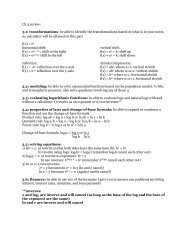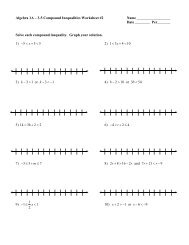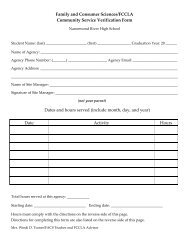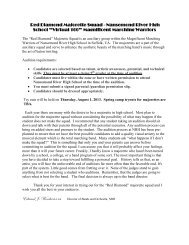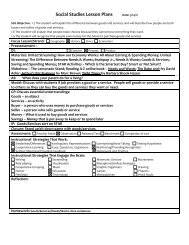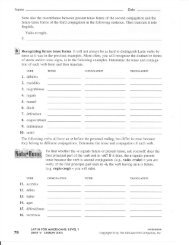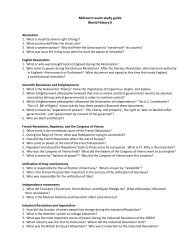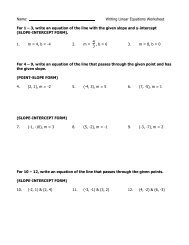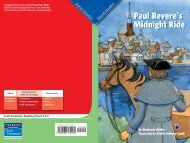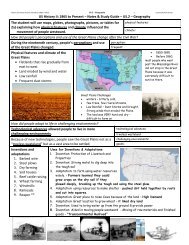US History Portfolio 1877 - Suffolk Public Schools Blog
US History Portfolio 1877 - Suffolk Public Schools Blog
US History Portfolio 1877 - Suffolk Public Schools Blog
You also want an ePaper? Increase the reach of your titles
YUMPU automatically turns print PDFs into web optimized ePapers that Google loves.
<strong>Suffolk</strong> <strong>Public</strong> School’s<strong>Portfolio</strong> Packet3 rd Nine WeeksStudent’s Name: ________________________________School: ________________________________________Accelerated Course: 6 th Grade <strong>US</strong> <strong>History</strong> .Core Teacher: __________________________Block: ___Gifted Resource Teacher: _________________________This packet must be submitted at the conclusion of this nineweek grading period, along with evidence of completed work.Date Submitted: _____________________________________________________________________Student Signature____________________________________GRT SignatureGRT Comments:www.starkclassroom.com® | Designed by: Pamela Stark, GRT 1
WWW.STARKCLASSROOM.COM®<strong>US</strong> <strong>History</strong> Reconstruction through the Great DepressionThe Building Blocks of Modern AmericaTimes of ChangePamela Stark, M.S.EdGifted Resource TeacherSpring 2013Students will explore the many facets of <strong>US</strong> <strong>History</strong> ranging in from Reconstruction through the Great Depression. Students willwork on this ongoing independent project/research based activity using internet, texts, INB and supplemental materials. Studentswill continue to use skills of historical and geographical analysis as they examine American history since 1865. The standards for thiscourse relate to the history of the United States from the end of the Reconstruction era to the present (Although this packet isspecific to 1986 – 1939). Students should continue to learn fundamental concepts in civics, economics, and geography within thecontext of United States history. Political, economic, and social challenges facing the nation reunited after civil war will be examinedchronologically as students develop an understanding of how the American experience shaped the world political and economiclandscapes. The study of history must emphasize the intellectual skills required for responsible citizenship. Students practice theseskills as they extend their understanding of the essential knowledge defined by all of the standards for history and social science.www.starkclassroom.com® | Designed by Pamela Stark, GRT 2
Welcome to 6 th Grade <strong>US</strong> <strong>History</strong>During this semester, you will be responsible for studying preselected events from United States<strong>History</strong> ranging from 1865 – to the present. 6 th grade <strong>US</strong> history begins at the end of the Civil War(1861-1865) with Reconstruction (1865-<strong>1877</strong>) and continues on to modern conflicts (including theterrorist attacks of September 11, 2001). Students are expected to remember state standards from 5 thgrade <strong>US</strong> history, which included events and people of the Civil War. 6 th grade standards will touchupon 5 th grade standards, but will not re-teach them. Below is an overview of some the topics that willbe explored throughout this course:Reconstruction (1865-<strong>1877</strong>) Great Depression (1929-1939)Westward Expansion (1850-1900) World War II (1939-1945)Spanish-American War (1898) The Cold War (1945-1991)Imperialism (1890-1917) The Korean (Police Action) War (1950-1953)World War I (1914-1919) The Vietnam (Conflict) War (1958-1975)The Progressive Movement (1900-1920s) Space Race (1960s)Roaring 20s, Harlem Renaissance (1920s) Modern America/Terrorism (1990 – 2011)In addition to people, places and events of these times periods, students are also expected to be ableto:• read and interpret maps, charts, graphs and political cartoons• identify locations based on latitude and longitude coordinates• make reasonable comparisons to different time periods• be able to match quotes/images to their respective time periods without dates• use context clues to decipher time periods/events/imagesWhile each history teacher may have their own individual rules and procedures for their classrooms,there are a few universal expectations and guidelines for ALL 6 th grade history students enrolled in<strong>Suffolk</strong> <strong>Public</strong> <strong>Schools</strong> Accelerated Courses:1. Cheating of any kind will result in a “0”/”F” grade and an administrative referral.2. Using sources of information and not citing the source or plagiarizing (copying) the source will beconsidered cheating and will result in a “0”/”F” grade and an administrative referral.3. All assignments are due on the assigned date. Late work, non-absence related, will not be acceptedunless extenuating circumstances exist and said circumstances have been discussed betweenparent/guardian and teacher and all parties involved have agreed to a solution.4. ALL students will conduct themselves in a respectful manner and in accordance to <strong>Suffolk</strong> <strong>Public</strong><strong>Schools</strong> conduct guidelines.5. Students will be responsible for seeking out missing work due to absences.These unit packets can be electronically accessed at www.starkclassroom.com. If there are ever anyquestions or concerns, please do not hesitate to contact your assigned <strong>History</strong> Teacher or GRT.Core Teacher: ___________________________________ Email: ______________________________________________________GRT (JFK, KFMS, JYMS): Pamela Stark Email: starkclassroom@gmail.com or pamelastark@spsk12.net___________GRT (KFMS): Debra Curran Email: debracurran@spsk12.net __________________________GRT (JYMS): Renee Wagner Email: reneewagner@spsk12.net ___________________________________GRT (FGMS, JYMS): Linda Ellis Email: lindaellis@spsk12.net _______________________________________Student Name (please print)_____________________________Parent Signature: ________________________________________www.starkclassroom.com® | Designed by Pamela Stark, GRT 3
3 rd Nine Weeks Unit Lesson PlanTime Allottment:9 weeks (one quarter)Curriculum Standards: Adaptations fromSkills<strong>US</strong>II.1 The student will demonstrate skills for historical and geographical analysis, including the ability toa) analyze and interpret primary and secondary source documents to increase understanding of events and life inUnited States history from <strong>1877</strong> to the present;b) make connections between past and present;c) sequence events in United States history from <strong>1877</strong> to the present;d) interpret ideas and events from different historical perspectives;e) evaluate and debate issues orally and in writing;f) analyze and interpret maps that include major physical features;g) use parallels of latitude and meridians of longitude to describe hemispheric location; interpret patriotic slogansand excerpts from notable speeches and documents.Geography<strong>US</strong>II.2 The student will use maps, globes, photographs, pictures, and tables fora) explaining how physical features and climate influenced the movement of people westward;b) explaining relationships among natural resources, transportation, and industrial development after <strong>1877</strong>;c) locating the 50 states and the cities most significant to the historical development of the United States.Reconstruction: 1865 to <strong>1877</strong><strong>US</strong>II.3 The student will demonstrate knowledge of the effects of reconstruction bya) analyzing the impact of the 13th, 14th, and 15 th Amendments to the Constitution of the United States;b) describing the impact of Reconstruction policies on the South and the North;c) describing the legacies of Abraham Lincoln, Robert E. Lee, and Frederic Douglas;Reshaping the Nation and the Emergence of Modern America: <strong>1877</strong> to the Early 1900s<strong>US</strong>II.4 The student will demonstrate knowledge of how life changed after the Civil War bya) identifying the reasons for westward expansion, including the impact on American Indians;b) explaining the reasons for the increase in immigration, growth of cities, new inventions, and challenges arisingfrom this expansion;c) describing racial segregation, the rise of “Jim Crow,” and other constraints faced by African Americans in thepost-Reconstruction South;d) explaining the impact of new inventions, rise of big business, the growth of industry, and life on Americanfarms;e) describing the impact of the Progressive Movement on child labor, working conditions, the rise of organizedlabor, women’s suffrage, and the temperance movement.Turmoil and Change: 1890s to 1945<strong>US</strong>II.5 The student will demonstrate knowledge of the changing role of the United States from the late nineteenth centurythrough World War I bya) explaining the reasons for and results of the Spanish American War;b) describing Theodore Roosevelt’s impact on the foreign policy of the United States;c) explaining the reasons for the United States’ involvement in World War I and its leadership role at theconclusion of the war.<strong>US</strong>II.6 The student will demonstrate knowledge of the social, economic, and technological changes of the early twentiethcentury bya) explaining how developments in factory and labor productivity, transportation (including the use of theautomobile), communication, and rural electrification changed American life and standard of living;b) describing the social changes that took place, including prohibition, and the Great Migration north and west;c) examining art, literature, and music from the 1920s and 1930s, with emphasis on Langston Hughes,Duke Ellington, and Georgia O’Keeffe and including the Harlem Renaissance;d) identifying the causes of the Great Depression, its impact on Americans, and the major features of Franklin D.Roosevelt’s New Deal.www.starkclassroom.com® | Designed by Pamela Stark, GRT 4
Lesson Objectives:Students will demonstrate their knowledge of the ever evolving American culture,geographic regions and localities, as well as internal and external conflicts by exploringAmerican history standard topics –Regions and Geography of the <strong>US</strong> Reconstruction Westward ExpansionImpact on Native Americans Jim Crow Laws Spanish-American WarProgressive Movement Industrialization ImmigrationWorld War I Roaring Twenties & Jazz Age Great Depression & the New DealStudents will also be expected to describe the legacy of the following individuals:Individuals required to be identified as part of Virginia’s <strong>US</strong>II SOLsAbraham Lincoln Robert E. Lee Fredrick DouglassChief Joseph Sitting Bull GeronimoBooker T. Washington W.E.B. DuBois Thomas EdisonAlexander Graham Bell John D. Rockeller Andrew CarnegieCornelius Vanderbilt Jane Addams Susan B. AnthonyElizabeth Cady Stanton President Theodore Roosevelt President Woodrow WilsonThe Wright Brothers Georgia O’Keeffe F. Scott FitzgeraldJohn Steinbeck Aaron Copland George GershwinJacob Lawrence Langston Hughes Duke EllingtonLouis Armstrong Bessie Smith President Franklin D. RooseveltIndividuals expected to be presented as part of the Accelerated Course (based on American <strong>History</strong> SOLs)Jefferson Davis Ulysses S. Grant President Grover ClevelandColonel Custer Boss Tweed Ida B. WellsJ.P. Morgan Cyrus McCormick Commodore DeweyArch Duke Franz Ferdinand Gavrilo Princip Wilhelm IIArthur Zimmermann Al Capone President Herbert Hooverwww.starkclassroom.com® | Designed by Pamela Stark, GRT 5
Geography ReviewThere are ____ continents on Earth. These continents are:1. ____________________________________ 5. ___________________________________2. ____________________________________ 6. ___________________________________3. ____________________________________ 7. ___________________________________4. ____________________________________In addition to the ____ continents, there are ____ oceans. They are:1. ____________________________________ 4. ___________________________________2. ____________________________________ 5. ___________________________________3. ____________________________________Being able to locate the various continents and oceans will help you in understanding various events in history.LOCATION, LOCATION, LOCATION!Using geographic coordinates called Latitude and Longitude lines help locate specific places on the Earth.Modern GPS’ use latitude and longitude coordinates from satellites to help us find places such as stores,restaurants, etc…Mrs. Longitude Mr. “Fat”itude CoordinatesLongitude line run North to Southbut measure East to West.Latitude lines run East to Westbut measure North to South.Coordinates mark theintersecting points ofLongitude and Latitude lines.www.starkclassroom.com® | Designed by Pamela Stark, GRT 6
Name: _______________________________________________________________starkclassroom®Latitude and Longitude’s Coordinated ImageDate: _______________________Directions: Lines of Latitude and Longitude allow us to pin point exact locations on a map. When lines of latitude and longitude intersect they createcoordinates. Use your text books to research events that have transpired in American history. Mark the coordinates of 6 events (any time period) on this mapwith a “ “mark. Then on the back of this map, write the numeric placement of the coordinates in terms of latitude and longitude. Next to each of thecoordinates on the back of this page, you will find a prompt asking you to briefly describe the event that you marked. The goal on this map is to create a picture,abstract is fine, by drawing lines to connect the plot coordinates, based on the events in American history that you have already marked. Good Luck!www.starkclassroom.com® | Designed by Pamela Stark, GRT 8
Latitude and Longitude CoordinatesDirections: As you work on the map of the United States be sure to add the required information below. Remember – On map of the United States you mustbegin your coordinate with the line of Latitude, followed by the line of Longitude. Example: <strong>Suffolk</strong>, Virginia is located at 36° 43' 41" N X 76° 35' 2" W butwe would round the coordinate to 36°N X 76°W.Plot 1Coordinate: ___________________________State/Region___________________________Date:_________________________________Event:_____________________________________________________________________Plot 2Coordinate: ___________________________State/Region:__________________________Date:_________________________________Event:_____________________________________________________________________Plot 3Coordinate: ___________________________State/Region:__________________________Date:_________________________________Event:_____________________________________________________________________Plot 4Coordinate: ___________________________State/Region:__________________________Date:_________________________________Event:_____________________________________________________________________Plot 5Coordinate: ___________________________State/Region:__________________________Date:_________________________________Event:_____________________________________________________________________Plot 6Coordinate: ___________________________State/Region:__________________________Date:_________________________________Event:_____________________________________________________________________Now, Looking at the placement of your coordinates on the <strong>US</strong> map, connect the lines in a way that enables you to create an image. In this box, please describethe image you created on the original map:www.starkclassroom.com® | Designed by Pamela Stark, GRT 9
Making a Modern Connection to ReconstructionDirections: The amendments below guarantee equal protection under the law for all citizens. Using the internet, magazines, newspapers, or anyother accredited news source, find a modern “story” that shares a specific link to each the following amendments (3 articles total). In the boxesbelow, describe the connection you see between the article and the “Reconstruction Amendments”. Be sure to have a copy of each article for full credit.13 th Amendment 14 th Amendment 15 th Amendmentwww.starkclassroom.com® | Designed by: Pamela Stark, GRT 10
Famous People Cards of the Civil War and Reconstruction EraDirections: For each of the following 12 people cards, you are responsible for writing a biographical excerptabout how their involvement in the Civil War and/or Reconstruction shaped American <strong>History</strong>. You willneed to [1] cut out each card and [2] write a biographical excerpt on the back of each card. You may add details,color, or modify the cards in any fashion you see fit as long as the integrity of the biography is present andaccurate.Cut along the dotted lines to release the cards from this packet Cut along the dotted lines to release the cards from this packet www.starkclassroom.com® | Designed by Pamela Stark, GRT 11
Cut along the dotted lines to release the cards from this packet www.starkclassroom.com® | Designed by Pamela Stark, GRT 12
Cut along the dotted lines to release the cards from this packet www.starkclassroom.com® | Designed by Pamela Stark, GRT 13
READING PROMPT: Developing a Political VoiceThe south was devastated – physically, economically, and spiritually – after the Civil War. Lincoln’s planhad been to bring the rebellious states back into the Union with as little trouble from them as possible.After Lincoln’s death, his successor Andrew Johnson (1808-1875), wanted to follow Lincoln’s plan, butRadical Republicans wanted to make it much more difficult for the states that had seceded to rejoin theUnion. The Radical Republicans were more powerful than Johnson, and had their way. They divided theSouth into military regions under the command of generals. They also required the states to adoptconstitutions that allowed blacks to vote and to accept the Fourteenth Amendment, which extendedcitizenship to blacks.[1] Write a response either in favor of moderate reconstruction or in favor of harsher reconstruction. [2]Which argument do you believe is stronger? [3] Defend your reasoning. [4] Why do you think manynortherners wanted to make readmission to the Union difficult for the rebellious states?____________________________________________________________________________________________________________________________________________________________________________________________________________________________________________________________________________________________________________________________________________________________________________________________________________________________________________________________________________________________________________________________________________________________________________________________________________________________________________________________________________________________________________________________________________________________________________________________________________________________________________________________________________________________________________________________________________________________________________________________________________________________________________________________________________________________________________________________________________________________________________________________________________________________________________________________________________________________________________________________________________________________________________________________________________________________________________________________________________________________________________________________________________________________________________________________________________________________________________________________________________________________________________________________________________________________________________________________________________________________________________________________________________________________________________________________________________________________________________________________________________________________________________________________________________________________________________________________________________________________________________________________________________________________________________________________________________________________________________________________________________________________________________________________________________________________________________________________________________________________________________________www.starkclassroom.com® | Designed by Pamela Stark, GRT 14
______________________________________________________________________________________________________________________________________________________________________________________________________________________________________________________________________________________________________________________________________________________________________________________________________________________________________________________________________________________________________________________________________________________________________________________________________________________________________________________________________________________________________________________________________________________________________________________________________________________________________________________________________________________________________________________________________________________________________________________________________________________________________________________________________________________________________________________________________________________________________________________________________________________________________________________________________________________________________________________________________________________________________________________________________________________________________________________________________________________________________________________________________________________________________________________________________________________________________________________________________________________________________________________________________________________________________________________________________________________________________________________________________________________________________________________________________________________________________________________________________________________________________________________________________________________________________________________________________________________________________________________________________________________________________________________________________________________________________________________________________________________________________________________________________________________________________________________________________________________________________________________________________________________________________________________________________________________________________________________________________________________________________________________________________________________________________________________________________________________________________________________________________________________________________________________________________________________________________________________________________________________________________________________________________________________________________________________________________________________________________________________________________________________________________________________________________________________________________________________________________________________________________________________________________________________________________________________________________________________________________________________________________________________________________________________________________________________________________________________________________________________________________________________________________________________________________________www.starkclassroom.com® | Designed by Pamela Stark, GRT 15
Westward ExpansionDirections: Using the information that you have learned from class and your own independent research, createone of the following projects.CollageA collage is the art of creating pictures by stickingcloth, pieces of paper, photographs, and otherobjects onto a surface. You may also draw picturesto make a collage. Using any medium, design andmake a collage about the Great Plains and westwardexpansion. Your collage must contain the following: At least 3 reasons for westward expansion At least 4 inventions At least 1 physical feature Aesthetics, collage should be neat, and colorfulName on back of projectDiary or Journal EntryA diary or journal is a daily record, especially a personalrecord of events, experiences, and observations. Createa pioneer personality for yourself and write a week’sworth of experiences you encounter along the GreatPlains during westward expansion. Your diary entryshould contain the following : Describe who you are, what your name is, where youare from, where you are going and why, and who iswith you. At least 3 reasons for westward expansion At least 4 inventions At least 1 physical feature At least 2 illustrationsPropaganda PosterPropaganda is the use of publicity to promotesomething like westward expansion. It isinformation put out by an organization orgovernment to promote a policy, idea, or cause.Using propaganda, create a propaganda poster onthe Great Plains and westward expansion. Yourposter must contain the following: At least 3 reasons for westward expansion At least 4 inventions At least 1 physical featureBalladA ballad is a poem that tells a story similar to a folk taleor legend which often has a repeated refrain. Manyballads also contain a moral which is expressed (mostoften) in the final stanza.Example of a BalladJohn HenryAppalachian Folk BalladJohn Henry said to his CaptainI ain't nothing but a man,But before I'll let your steam drill beat me down,I'll die with my hammer in my hand, Lord, Lord,I'll die with my hammer in my hand."John Henry got a thirt pound hammer,Beside the steam drill he did stand.He beat that steam drill three inches down,And he died with his hammer in his hand, Lord, Lord,He died with his hammer in his hand. At least 3 reasons for westward expansion At least 4 inventions At least 1 physical feature At least 5 stanzaswww.starkclassroom.com® | Designed by: Pamela Stark, GRT 16
Progressive MovementDirections: You are responsible for creating a Progressive Movement Project that will contain information onALL of the following four topics:1. The Rise of Big Business and Industrialization 2. Unions, AFL, and Progressive Era3. 18 th Amendment and Prohibition 4. 19 th Amendment and Women’s SuffrageEach topic above should explain what influence the Progressive Era had on it. Each topic should be explainedby covering the 5 W’s: Who, What, When, Where, and Why in no less than 5 complete sentences (1 sentencefor each W)= 20 complete sentences total. You are welcome to use more sentences, but you will be gradedby the 5 W’s for each topic.UNDER NO CIRCUMSTANCES CAN THE 5 Ws BE COPIED DIRECTLY FROM THE INTERNET,OUT OF A TEXTBOOK OR ENCLYCLOPEDIA – ALL SENTENCES M<strong>US</strong>T BE IN THE STUDENT’SOWN VOICE. ANY PLAGIARISM WILL RESULT IN A GRADE OF “0/F”.Each topic should have one or more picture(s) to describe it and will be graded accordingto the elaboration of the topic (FOR A TOTAL OF 5+ PICTURES)You have several choices as to how you would like to present your project:Poster format - broken into the 4 topics Flip-book form covering all 4 topicsReport form covering all 4 topics 4 Sided box format - each side covering one topic=4 topics totalIf you have any other creative ideas to present your project, please be sure to get approval before you begin.Use your imagination! This should not be a chore---have fun!The Rise of BigBusiness andIndustrializationRough Draft SpaceUnions, AFL, andProgressive Era18 th Amendment andProhibition19 th Amendment andWomen’s SuffrageWhoWhatWhereWhenWhywww.starkclassroom.com® | Designed by Pamela Stark, GRT 17
World War IPART I: Alliance Game (In Class Activity)Student Instructions:1. The class will be divided into five more-or-less equal groups. The groups represent: Austria-Hungary, Russia,Germany, France and Great Britain. The teacher will play as Serbia and Belgium.The date is the end of July, 1914 (just after the Austrian ultimatum).2. Each member of the group must choose one of the following positions: Prime Minister = Hear arguments and accept or decline alliances; sign alliance agreements Secretary of State = Travels to other countries to make alliance offers Scribe = Documents alliance offers Minister of War (if necessary) = Makes the decision to accept or decline alliances.3. Each country will then receive a package containing the following: A factsheet about the 5 countries involved The military strength of each country Secret instructions from their government Multiple “alliance agreements”4. Each nation will have 15 minutes to study their positions, beliefs and alliances. These should determine youractions for at least the first round of the game.5. The Game: Starting with the major aggressors (Austria-Hungary then Russia, Germany, France and GreatBritain), each country has the opportunity to declare war on another country. When war isdeclared, the countries involved have the opportunity to call on their alliances for assistance.These countries can then either enforce their allegiance or decline. The dice is then rolled by the teacher to determine the winner. The number of rolls is determinedby the number of troops/navy for each country (including the troops of their allies). Every100,000 = 1 roll. The results of the battles can be a draw, a defeat or a conquest. A defeated country looses ½ oftheir troops to the winner. A conquered country looses all their troops ( ½ to the winner and ½ tothe winners allies) and their land. The game is played until there is only 1 winner.6. After the first round, each remaining country has the opportunity to create new alliances. You will have 15minutes between each round to send your Secretary of State around to offer alliances. Countries may chooseto align themselves with other countries either fully, both offensively and defensively, or solely defensive. Youcan only make 1 new alliance each round.7. When war is declared, both countries can call on their alliances for support. Their allies can then choose toenforce their alliance or refuse. REMEMBER: if you refuse, other countries will be less likely to trust you andform alliances with you in the future.www.starkclassroom.com® | Designed by Pamela Stark, GRT 18
WWI MILITARY STRENGTHCOUNTRY ARMY SIZE RATING-------------- -------- ----------- -------------Belgium Yes 95,000 PoorGreat Britain Yes 220,000 GoodSerbia Yes 100,000 FairGermany Yes 775,000 ExcellentRussia Yes 850,000 PoorFrance Yes 375,000 GoodAustria-Hungary Yes 275,000 GoodCOUNTRY NAVY SIZE RATING-------------- -------- ----------- -------------Belgium Yes 5,000 FairGreat Britain Yes 80,000 ExcellentSerbia No --------- NoneGermany Yes 25,000 FairRussia Yes 50,000 FairFrance Yes 25,000 GoodAustria-Hungary Yes 25,000 PoorCOUNTRY TOTAL STRENGTH COUNTRY TOTAL STRENGTH--------------- --------------------------- --------------- ------------------------Belgium 100,000 Austria-Hungary 300,000Great Britain 300,000 Germany 800,000Russia 900,000 France 400,000Serbia 100,000www.starkclassroom.com® | Designed by Pamela Stark, GRT 19
PART II: Reflection (At Home Activity)Directions: In 2-3 complete sentences each, respond to the following questions based on The Alliance Game weplayed in class.1. What was the purpose for playing this game? In other words, what did it have to do with WWI?2. Why do you think alliances were necessary for countries to form before WWI? (Hint: think about themilitary strengths!)3. How did the alliance system help cause WWI?4. In our version of the game, did alliances help balance the war or make things uneven? How?5. In our game, which countries were able to choose any alliances they wanted and why?6. After playing this game, do you have a better understanding of the alliance system during WWI?Please elaborate on your thoughts:www.starkclassroom.com® | Designed by Pamela Stark, GRT 20
Roaring TwentiesDirections: The student will present their interpretation of the complexities associated with the rise in artisticexpression of the 1920s by designing a museum which will feature wings/exhibits reflecting specific people, artisticgenres, as well as economic and cultural characteristics of the 1920s.Each of the following people/events/topics must be present in your museum layout:Langston Hughes Bessie Smith Harlem RenaissanceGeorgia O’Keeffe F. Scott Fitzgerald John SteinbeckAaron Copland George Gershwin Jacob LawrenceDuke Ellington Louis Armstrong Jazz AgeThe Museum map on the next page should be [1] cut out and glued down to a large piece ofconstruction paper. You have the freedom to modify the museum blueprint (add/delete walls).[2] label each exhibit – Name and Number. You may add a gift shop, restrooms and office if youchoose but they do not count towards the exhibit requirements. [3] Around the boarder of yourmuseum blueprint (on the construction paper), you must write 3 details about what a visitorwould be able to see/hear in each exhibit – 12 exhibits total.Example:www.starkclassroom.com® | Designed by Pamela Stark, GRT 21
Museum Blueprintwww.starkclassroom.com® | Designed by: Pamela Stark, GRT 22
The Great DepressionWho’s to Blame for America’s Great Depression?The effects of the Great Depression were:Long LastingIsolatedWidespreadWithout WarningStronglyAgree5Agree4Neutral3Disagree2StronglyDisagree1The Great Depression:*effected all social classes in the <strong>US</strong> 5 4 3 2 1*could have been avoided 5 4 3 2 1*is the result of economic mismanagement by government 5 4 3 2 1*is the result of economic mismanagement by the people 5 4 3 2 1When and where was theGreat Depression firstidentified?Who was president of the <strong>US</strong>when the Stock Marketcrashed?What events had transpiredprior to the Stock Marketcrash?How could the GreatDepression have beenavoided?Are there any positiveattributes of the GreatDepression?Who do you believe is ultimately responsible for the catastrophic events of the Great Depression?______________________________________________________________________________www.starkclassroom.com® | Designed by: Pamela Stark, GRT 23
The New DealDirections: Using the spectrum scale below, please [1] rank the following New Deal programs in accordance to influence/impact on AmericanSociety and [2] describe in detail, the effectiveness of each program.Works ProgressAdministrationAgricultural AdjustmentAdministrationSecurity and ExchangeCommissionFederal DepositInsurance CorporationSocial SecurityAdministrationLeast Positive InfluenceMost Positive Influencewww.starkclassroom.com® | Designed by: Pamela Stark, GRT 24
Times of ChangeRequired AssignmentsThe following are required assignments that each student must completeDue Date Assignment <strong>US</strong> <strong>History</strong> <strong>Portfolio</strong>3 rd 9 weeks Activity Page/sGeography Review & <strong>US</strong>II. 2c Regions: Review for UnderstandingPgs. 6 & 7 (In-Class)Score4= Advanced3= Proficient2= Basic1=Below BasicLatitude and Longitude’s Coordinated ImageProgressive Movement (Will also count as a Project/Class work grade)World War I Part I: SimulationThe Roaring Twenties Museum Exhibit (Will also count as a Project/Class work grade)Pgs. 8 & 9 ( Begin In-Class, unfinished work must be completed at home)Pg. 17 (At Home)Pgs. 18 & 19 (In-Class)Pgs. 21 & 22 (In-Class)Student Selected ActivitiesStudents must complete 3 out of the 6 assignments below. These home-based activities must be turned in on the assigned due date to receive credit. Additional activities may be completed to earn bonus points.Due DateAssignment<strong>US</strong> <strong>History</strong> <strong>Portfolio</strong>3 rd 9 weeks Activity Page/sMaking a Modern Connection to Reconstruction Pg. 10Score4= Advanced3= Proficient2= Basic1=Below BasicFamous People Cards of the Civil War and Reconstruction Era Pgs. 11, 12 & 13Reading Prompt: Developing a Political Voice Pgs. 14 & 15Westward Expansion Pg. 16World War I Part II: Reflection Pg. 20The Great Depression & The New Deal Pgs. 23 & 24Teacher Comments:\Total Points Earned40Test Score Earnedwww.starkclassroom.com® | Designed by: Pamela Stark, GRT 25





